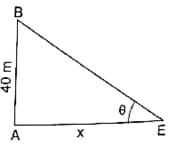Derivative as a Rate Measure
Important Questions on Derivative as a Rate Measure
A man is moving away from a high tower at a speed of . Find the rate is which the angle of elevation of the top of the tower is changing when he is at a distance of metres from the foot of the tower. Assume that the eye level of the man is from the ground.

A long ladder is leaning against a wall. The bottom of the ladder is pulled along the ground, away from the wall, at the rate of . How fast is its height on the wall decreasing when the foot of the ladder is away from the wall?
Oil is leaking at the rate of from a vertically kept cylindrical drum containing oil. If the radius of the drum is and its height is , find the rate at which the level of the oil is changing when the oil level is .
The side of an equilateral triangle are increasing at the rate of . Find the rate at which the area is increasing when the side is .
An edge of a variable cube is increasing at the rate of . How fast is the volume of the cube increasing when the edge is long?
The radius of a balloon is increasing at the rate of . At what rate is the surface area of the balloon increasing when the radius is ?
An angle which increases twice as fast as its sine. Find the value of .
Water is dripping through a tiny hole at the vertex in the bottom of a conical funnel at a uniform rate of . When the slant height of the water is , the rate of decrease of the slant height of the water in , given that the vertical angle of the funnel is is . Find . (Take )
Sand is pouring from a pipe at the rate of . The falling sand forms a cone on the ground in such a way that the height of the cone is one-sixth of the radius of the base. Height of the sand cone increasing when its height is is , where are smallest positive integers. Find . (Take )
An inverted cone has a depth of and a base of radius . Water is poured into it at a rate of cubic centimetres per minute. The rate at which the level of water in the cone is rising when the depth is in is , where and are smallest positive integers . Find. (Take )
A tall man walks at a uniform speed of away from a high lamp post. Find the rate at which the length of his shadow increases in .
A stone is dropped into a quiet lake and waves move in circles at a speed of . At the instant when the radius of the circular wave is if the enclosed area is increasing at the rate of , then what is the value of ? (Take )
The radius of a circle is increasing at the rate of . What is the rate of increase of its circumference in ? (Take )
The side of a square is increasing at the rate of . If the rate of increase of the perimeter of the square is , then the value of is
The bottom of a rectangular swimming tank is by . Water is pumped into the tank at the rate of cubic metres per minute. Find the rate at which the level of water in the tank is rising in .
A balloon which always remains spherical is being inflated by pumping in cubic centimetres of gas per second. Find the rate (in ) at which the radius of the balloon is increasing when the radius is . Use (Round off final answer to two decimal places and enter the value excluding units)
The volume of a spherical balloon is increasing at the rate ofcubic centimetres per second. Find the rate of change of its surface in at the instant when its radius is .
The radius of an air bubble is increasing at the rate of centimetre per second. At what rate is the volume of the bubble increasing in when the radius is centimetre? (Take )
The radius of a spherical soap bubble is increasing at the rate of . If the rate of increase of its surface area when the radius is is , then find the value of . (Take )
{Write the answer in decimal form}
The side of a square sheet of a metal is increasing at a rate of centimetres per minute. At what rate is the area increasing in when the side is long?

